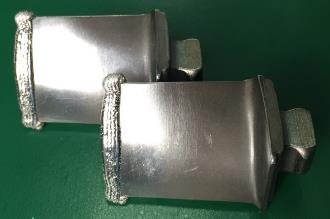Have any questions?
Get in touch-
Tel : +86 18355532477
-
Whatsapp : +8618355532477
-
Email : 247137166@qq.com
-
Skype : 247137166@qq.com
Have any questions?
Get in touchTel : +86 18355532477
Whatsapp : +8618355532477
Email : 247137166@qq.com
Skype : 247137166@qq.com
Payment:
TTProduct origin:
ChinaShipping port:
Shanghai PortAirplane engine compressor blades repair
Product Description:
Commonly used repair methods for aircraft engine compressors include arc welding, plasma welding, and laser powder coating 3D printing.
Arc welding and plasma welding not only have a large heat input, but also cannot solve the micro-undercut phenomenon at the inlet and outlet sides of the blade and cause serious deformation. Laser powder coating 3D printing has low efficiency, high cost and low pass rate for repairing blade tips.
WILA laser cladding technology can reduce maintenance costs and avoid losses in all aspects.
Product Show:
The laser cladding technology uses a high-power laser beam to focus on optical elements to obtain a very high energy density, instantaneously melts the surface of the substrate, and at the same time makes the alloy powder preset or automatically sent to the surface of the substrate in synchronization with the laser beam to be completely melted to obtain Dense cladding with metallurgical bonding. The bonding strength is generally not less than 95% of the original matrix material. The matrix material can achieve surface micro-melting during laser processing, the micro-melting layer is 0.05-0.1mm, and the heat-affected zone of the matrix is extremely small, generally 0.05-0.5mm. Both the cladding layer and the matrix have no coarse casting structure, and the cladding layer and its interface have dense structure, fine grains, no voids, no inclusion cracks and other defects. The temperature rise of the substrate during laser processing does not exceed 80°C. The deformation after laser processing is calculated as 0.01mm. After cladding, the stress is released after heat treatment. The amount of deformation will be calculated as 0.001mm, which can be ignored.

The thickness of the middle of the blade tip is the largest, and more power is required for cladding. If the laser is cladding with the same power, the thinnest part at both ends will be melted by this higher power, and it will not play a role in repairing. Therefore, in order to obtain the corresponding cladding width without melting the materials at both ends of the blade, variable power cladding is used. Because the two ends of the blade are extremely thin, the thickness of the two ends of the 8-level blade is only 0.2mm. Undercutting is easy to occur during laser cladding, so special treatment is required at both ends to solve the undercutting problem. It is necessary to rely on the laser coaxial imaging system for precise comparison during low-power cladding. The compressor rotor blades repaired at present have a good effect.
click here to leave a message